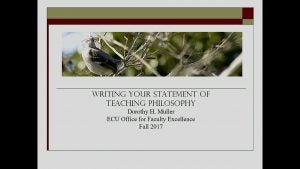Writing a Teaching Philosophy

A teaching philosophy is a reflection of your beliefs, values, and goals regarding teaching. It should also provide concrete examples of how you achieve these goals or endorse your beliefs in the classroom. In essence, its contents should represent who you are as a person and teacher.
Tips for Writing Your Teaching Philosophy Statement
 Please take a few moments to review this video from Dr. Dorothy Muller, former director of the ECU Office for Faculty Excellence.
Please take a few moments to review this video from Dr. Dorothy Muller, former director of the ECU Office for Faculty Excellence.
Your teaching statement should:
- explain what you want to accomplish and how your teaching is intended to bring that about, addressing both short and long-term goals for your teaching
- illustrate how you design your course content to meet University, departmental, and personal goals while facilitating student learning
- establish a connection between teaching and learning and your classroom practices
- suggest criteria for evaluating your work as a teacher
- demonstrate your engagement with central issues of teaching
- show your commitment to the improvement of your teaching
Questions to ask yourself when writing your statement of teaching philosophy:
- Where do you find your inspiration and/or motivation for teaching?
- What is your view of the teacher’s role in the classroom and with students?
- How do your teaching methods reflect your view?
- Has someone specific influenced your teaching style or approach to teaching – a mentor or past teacher? Why and how?
- How do you feel learning occurs?
- How do you build an intentional classroom culture?
- How do your personal characteristics and teaching style impact your students’ learning?
- How do you help students learn and develop as individuals?
- How do you provide different types of learning opportunities for different types of learners?
- What obstacles do you think students face and how do you help them overcome difficulties?
- How have you modified your methods in response to changes in students, course materials, your situation, changes in curriculum, or other mitigating factors?
- What do you feel you need to change in how you teach? What difference will this make? Express this plan for growth in terms of desired outcomes/underlying values.
General Criteria & Format of Teaching Philosophies
There is no required format for a teaching philosophy. Many different styles and approaches are considered acceptable. However, there are some general guidelines related to the content and formatting of your teaching statement.
- Statements of teaching philosophy are generally 1 to 2 pages in length, and rarely longer than 3 pages double spaced.
- Avoid using technical terms when writing your philosophy – while these terms may be understood by individuals within your own field, many times your teaching philosophy is reviewed by individuals from a variety of disciplines and backgrounds if you are being considered for a teaching award.
- Write your teaching philosophy in the present tense.
- Most teaching philosophies are written in a narrative format.
- Provide a few specific examples related to the approaches you use in your teaching.
- Remember to revise this regularly! Your teaching philosophy will – and should – evolve over time.
Tools and Resources
- Explore your Teaching Style
- Teaching Style Inventory – http://longleaf.net/teachingstyle.html
- Teaching Perspectives Inventory – http://www.teachingperspectives.com/tpi/
- Teaching Goals Inventory – https://tgi.its.uiowa.edu/teachinggoals/
- Examples from ECU Faculty
- External Resources for Writing a Teaching Philosophy